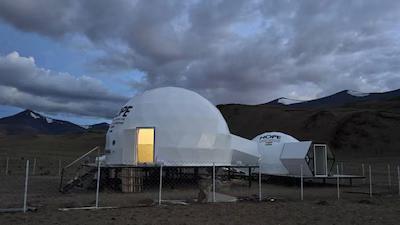
ISRO sets up station in Ladakh to simulate life on Moon & Mars
The Indian Space Research Organisation (ISRO) has taken a significant step towards exploring the possibilities of life on the Moon and Mars by setting up a special station in Ladakh’s Tso Kar Valley. The Himalayan Outpost for Planetary Exploration (HOPE) is a unique facility that will test life-support systems for lunar and Martian missions. The station will be occupied by a crew of two members who will conduct various tests over a period of 10 days, from August 1 to 10.
The Tso Kar Valley was chosen as the perfect location for the HOPE facility due to its extreme environmental conditions, which are similar to those found on Mars. The valley experiences high UV radiation, low atmospheric pressure, extreme cold, and saline permafrost, making it an ideal setting to simulate life on the Red Planet.
The HOPE facility is designed to mimic the harsh conditions that astronauts will face on a mission to Mars. The crew members will have to live in a specially designed habitat that is equipped with life-support systems, communication equipment, and other essential amenities. The crew will have to manage the habitat’s resources, including food, water, and energy, just like they would on a space mission.
During their 10-day stay at the HOPE facility, the crew members will conduct various tests to simulate life on Mars. They will have to manage the habitat’s systems, perform scientific experiments, and maintain communication with the outside world. The tests will help ISRO to identify any technical issues or challenges that may arise during a real-life mission to Mars.
The HOPE facility is not just a simulation exercise; it is also a step towards making India a major player in the field of space exploration. ISRO has been working towards sending humans to the Moon and Mars in the near future, and this facility is an important milestone in that journey.
The mission to Mars is a complex and challenging one, and ISRO is taking a comprehensive approach to ensure its success. The HOPE facility is just one part of the overall strategy, which includes developing advanced technologies, conducting extensive research, and testing various systems.
In addition to the HOPE facility, ISRO is also working on developing advanced life-support systems, including air, water, and food production. The organisation is also testing new technologies, such as solar panels and water recycling systems, to ensure that they are reliable and efficient.
ISRO is also working closely with international partners to share knowledge and expertise in the field of space exploration. The organisation is a member of the International Space Exploration Coordination Group (ISECG), which brings together space agencies from around the world to share information and coordinate efforts.
In conclusion, the HOPE facility in Ladakh’s Tso Kar Valley is an important milestone in India’s journey to explore the Moon and Mars. The facility will help ISRO to test life-support systems and simulate life on the Red Planet, paving the way for a future human mission to Mars.






